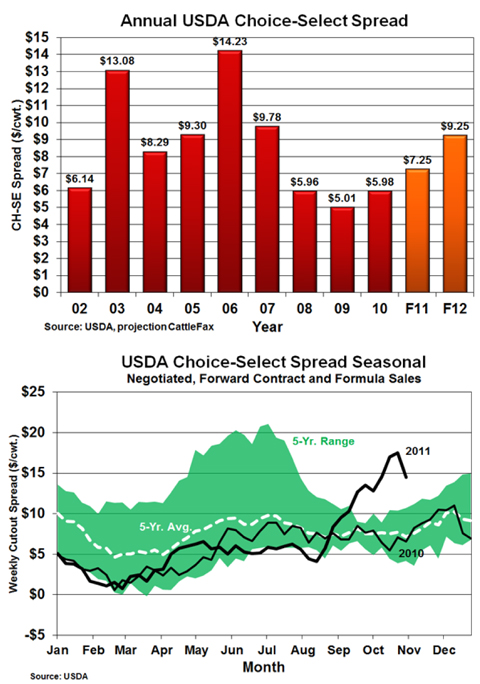
From CattleFAX.
Production of Choice beef dropped in the second half of the year. At the same time, Wal-Mart is dedicating a portion of its meat case to Choice beef after previously selling more Select product. The result has been escalating Choice prices and a historically wide Choice-Select spread. There is a chance the retailer could revert back to more Select product at some point in 2012, but let’s assume the transition to Choice is long term. What does this mean for cow-calf producers? It may influence producers in a variety of ways.
Regardless of the additional Choice demand, smaller forecasted cattle supplies for 2012 would likely result in declining Choice product next year and a wider than normal spread. The daily Choice-Select spread has reached a high of more than $19/cwt. this fall. Even if the Choice-Select spread moves back to $12 on a consistent basis, a feedlot selling on a formula or grid could earn $90 per head more for a Choice carcass than its Select-grading counterpart. That extra margin creates an incentive to produce Choice cattle that has not existed in recent years. It will result in more buyers looking for calves and feeder cattle with documented carcass performance – or at least the potential to grade Choice or better.
Cow-calf producers who can meet this demand should receive a premium for their investment in genetics and management. High quality genetics generally bring a premium in the marketplace. However, it is reasonable to expect bred females and bulls with proven genetics for marbling to generate additional interest this fall to spring. Auction markets will likely increase incentives to participate in value added programs to ensure producers receive the maximum return for those calves. Also, retained ownership will be more profitable for producers who understand the feedlot and carcass performance of their calves. Management practices that can increase a calf’s potential to grade – such as backgrounding or creep feeding – could also generate additional sale revenue.
Bottom Line: It appears that there will be a push for more Choice beef in the coming years. This presents an opportunity for additional returns to cow-calf producers and feedlot managers who can supply the industry with higher grading cattle. Anything producers can do to increase the quality grade potential of their cattle through management or genetics will be an added benefit, especially if producers can provide documentation. For instance, purchasing bulls that are genetically proven to produce Choice grading offspring may cost more but might be well worth it in the end. Value-added management practices in the coming year will need to be weighed against the potential for additional sales revenue based on the renewed market incentives for Choice-grading cattle.
